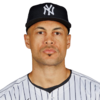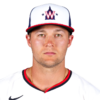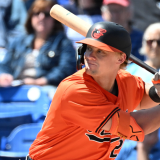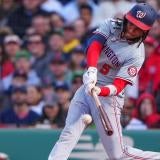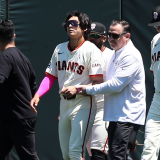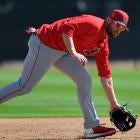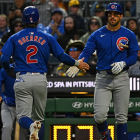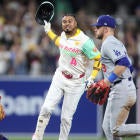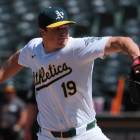Spring training is now well underway across Florida and Arizona, and with that several players have started the process of changing positions. Some are youngsters doing whatever they can to crack the Opening Day roster. Others are established veterans who are changing positions because their team told them they're more valuable elsewhere. It's not always an easy conversation.
Late last week the Padres signed Eric Hosmer, a move that pushes Wil Myers back into the outfield. Myers is changing positions but he's not moving to a new position. He played the outfield the first two and a half years of his big league career. Also, the Giants are shifting Andrew McCutchen back to right field this season, a position he played at the start of last season with the Pirates. He eventually moved back to his natural center field when Starling Marte was suspended.
With all due respect to Myers and McCutchen, let's take a look at the most notable position changes happening this season. This is a process that is now underway in spring training.
The Brewers made two of the biggest moves of the offseason within about an hour of each other a few weeks ago, when they acquired Christian Yelich in a trade with the Marlins and signed Lorenzo Cain as a free agent. Yelich and Cain join a crowded Milwaukee outfield unit that includes Ryan Braun, Domingo Santana, Keon Broxton, and Brett Phillips. There was talk the Brewers would deal an outfielder for a pitcher, but it hasn't happened.
Instead, in an effort to get everyone into the lineup, the Brewers are planning to use Braun at first base at least part of the time this season. Braun has never played the position before -- "I haven't worn a cup in over 10 years. I'll have to get one of those before I get super comfortable taking ground balls again," he joked to Tom Haudricourt of the Journal Sentinel -- but he is up for the challenge and is already taking grounders in camp.
Ryan Braun getting some reps at first base. @CBS58 @BrewCrewBall pic.twitter.com/nvNmWBZZrw
— Scott Grodsky (@ScottGrodsky) February 21, 2018
First base is incredibly hard, as Ron Washington famously said. Receiving throws from other infielders for a standard putout is the easy part. The tricky stuff is cutoff plays, knowing when to range to your right rather than letting the second baseman take it, things like that. Also, the game is just faster on the infield. Infielders don't have as much time to react to hard hit balls as outfielders.
Inexperience tends to show up at inopportune times, and given how much action a first baseman sees in a typical game -- first basemen make more than three times more putouts than any other position in a typical year -- there will be plenty of opportunities to screw up. Fortunately Braun has a month to work at the position this spring, and going from Braun to Yelich in left field is a substantial defensive upgrade that should more than make up for whatever Braun costs the Brewers at first base.
Angels GM Billy Eppler has assembled what figures to be the best defensive infield in baseball, at least on paper. The great Andrelton Simmons is at short, reigning Gold Glover Ian Kinsler is at second, and Zack Cozart was signed to take over third base. Cozart is a natural shortstop and damn a good one; he ranked seventh among all shortstops with +17 defensive runs saved from 2015-17.
Now Cozart is moving to third base, a position he has never played as a professional. In fact, Cozart has never played a position other than shortstop as a big leaguer. The last time he played a position other than shortstop was back in 2009, when he played four games at second base in the Arizona Fall League. It's been nothing but shortstop since. Yet the Angels brought Cozart in as a third baseman because they want a dynamite defensive infield.
Shortstop to third base is a fairly common late career move, so Cozart is not doing anything unprecedented here. Alex Rodriguez and Cal Ripken Jr. went from short to third, most notably. Alex Bregman made the move more recently as well. Plenty of others have done it too. Cozart has excellent defensive tools, and once he gets the lay of the land in spring training, I expect him to be one of the top defenders at the position in 2018.
Marlins turned Mariners speedster Dee Gordon is making the most extreme position change this season. Seattle acquired the career middle infielder -- Gordon started his career at shortstop before eventually settling in at second -- in the offseason with the intention of putting him in center field, a position he has barely played. (Gordon played nine games in center field in winter ball back in 2013.)
For what it's worth, Gordon is embracing the position change and looking forward to the challenge:
Never been afraid of a challenge.⚡️ pic.twitter.com/fgsUB5uFXh
— Dee Gordon (@FlashGJr) February 20, 2018
The good news is the "shift a speedy infielder to center field" move is a fairly common and often incredibly productive. Gordon is one of the fastest runners in baseball according to both the eye test and Statcast's sprint speed metric:
- Byron Buxton, Twins: 30.2 feet-per-second
- Billy Hamilton, Reds: 30.1 feet-per-second
- Bradley Zimmer, Indians: 29.9 feet-per-second
- Dee Gordon, Marlins: 29.7 feet-per-second
- Amed Rosario, Mets: 29.7 feet-per-second
That speed will give Gordon plenty of range in center field -- there sure is lots of ground to cover in the Safeco Field outfield -- and it'll also allow him to outrun any mistakes. Inevitably he'll get a bad read or take a bad route at some point. It's bound to happen given his inexperience. Gordon's legs can help him make up for that.
Hamilton is the most notable infielder-turned-center fielder in baseball right now, though he's hardly the only player who's made the transition. Odubel Herrera, Delino DeShields, and both Upton brothers went from the infield to center field early in their careers. Mookie Betts did as well before sliding over to right field.
Once he gets his legs under him in spring training, Gordon should be excellent in center field thanks to his speed. He's going to have range for days.
A case can be made the Yankees have the two best right fielders in baseball on their roster in Aaron Judge and Giancarlo Stanton. I'm not just talking offensively either. Check out the 2017 defensive runs saved leaderboard for right field:
- Mookie Betts, Red Sox: +31
- Yasiel Puig, Dodgers: +18
- Jason Heyward, Cubs: +18
- Giancarlo Stanton, Marlins: +10
- Aaron Judge, Yankees: +9
Judge and Stanton are known for their prodigious power and it's easy to understand why, but both men are sneaky good defensive right fielders too. Now they're on the same team and manager Aaron Boone has to figure out a way to get both into the lineup going forward. Boone plans to give both Judge and Stanton time in left field in spring training. Here's what the skipper said about his two right fielders during the Winter Meetings:
"We're going to juggle it. Those are things that we'll flesh out in spring training. Who do we believe potentially would move over to play left field in a 20, 30-game situation? Use the DH role strategically, play different matchups that give certain guys days off depending upon the matchups. It'll be a collaborative effort. What's the best fit, who's the most comfortable moving over and changing positions every now and then? The one thing we don't want to disrupt is what they bring to the table offensively."
Both Judge and Stanton said they're open to playing wherever, though neither has played left field in the big leagues, so it'll be an adjustment. The Yankees will try both guys in left during spring training and, chances are, whoever looks more comfortable at the position will get the job.
Of course, the Yankees are more likely to have Judge and Stanton split their time between right field and DH, with the defensively superior Brett Gardner getting most of the reps in left field. Still, the Yankees want to be able to have both Judge and Stanton in the outfield at the same time, so one will have to move to left field. Grapefruit League play will likely determine who stays in right and who shifts over to left when necessary.
For Manny Machado, the shift to shortstop represents a return to his natural position. He was drafted as a shortstop and he came up through the minors as a shortstop. It wasn't until Machado reached the big leagues that the Orioles shifted him over to the hot corner full-time -- Machado played a grand total of two minor league games at third base before being called up -- in deference to J.J. Hardy.
Unlike Braun and first base, or Cozart and third base, or Gordon in center field, Machado has shortstop experience at the MLB level. He's played 52 games at shortstop at the MLB level, including 45 games in 2016, when Hardy was on the disabled list. Moving back over to short should be a piece of cake for Machado, who is an outstanding defender. This is his contract year, remember. Machado showing he can handle shortstop for a full season could land him an even larger contract than expected next winter.
Perhaps the most interesting position change this offseason features a player who has yet to play in the big leagues. Reds third base prospect Nick Senzel, the second overall pick in the 2016 draft, is going to get some reps at shortstop this spring. He played the position a bit in college but has yet to do so during his relatively brief professional career.
#Reds manager Bryan Price said Nick Senzel will play SS & 3B in Cactus League play
— C. Trent Rosecrans (@ctrent) February 20, 2018
Simply put, if Senzel can handle shortstop, he might be the best prospect in the minors. Both Baseball America and MLB.com currently rank him as the seventh best prospect in baseball, and if Senzel can take his bat to shortstop -- he hit .321/.391/.514 with 40 doubles, 14 homers, and 14 stolen bases in 119 games split between High Class-A and Double-A last season -- he'd raise his profile considerably.
Here's what Baseball America has to say about Senzel's defensive chops:
Defensively, Senzel has shown the potential to be a plus defender at third with a strong, accurate arm that he has shown he can use on the run. He played shortstop and second base in addition to third base in college, but he has proven to be a quick study at third, working on his footwork with Pensacola bench coach Dick Schofield.
The Reds have the productive Eugenio Suarez locked in at third base -- Suarez made the short-to-third transition Cozart will be making this season, by the way -- so Senzel showing he can handle shortstop would give him an obvious spot with the big league club. He doesn't need to be a Gold Glover there. Senzel with an average glove at shortstop would be a perennial All-Star thanks to his bat.













